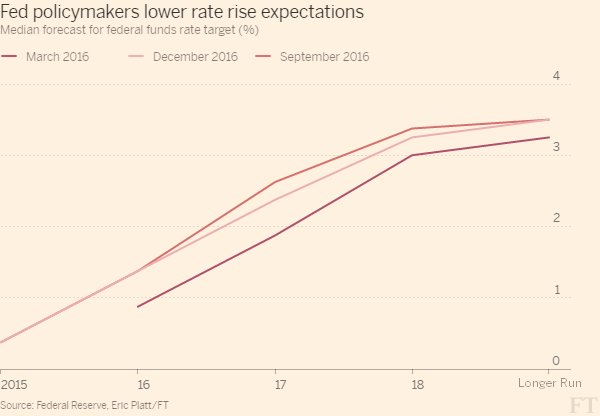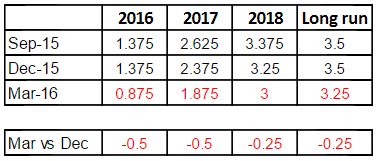Greetings,
We start with the United States where the Federal Reserve struck a dovish tone. While nobody expected a rate hike at this FOMC meeting, many viewed the latest pickup in inflation (discussed later) as potentially prompting the Fed to begin preparing the markets for more rate increases shortly. That didn’t seem to be the case, however.
The FOMC’s forecasts removed 2 rate hikes from 2016 and 2017 (table below shows median Fed Funds rate projections at different FOMC meetings).

Source: Natixis
The chart below shows the downshift in the median rate projections (dot plot).

Source: @fastFT
Moreover, the long-run fed funds rate projection was downgraded again by the FOMC.

Source: @SoberLook
The central bank also sharply cut the 2016 inflation forecast but left the core inflation figure unchanged.

Source: Natixis
It was interesting to see the FOMC cut the longer-run unemployment rate again (first chart below). The Committee seems to be of the belief that the unemployment rate can remain relatively low without igniting significant inflation (we see that in Japan for example). The second chart below shows the so-called “natural rate of unemployment” (NAIRU), reported by the US. Congressional Budget Office. It is a theoretical “equilibrium” measure of unemployment. Janet Yellen suggested that the declines in FOMC’s long-run unemployment forecast are driven by lower NAIRU.


Finally, the FOMC downgraded the long-run GDP growth forecast below 2%. What does that say about the Fed’s confidence in the US economy over the long-term?

Why has the FOMC turned more dovish? To a large part, it is the fact that as most major central banks are easing or remain dovish, the Fed’s policy is increasingly out of synch. That means that even a small rate hike packs a punch in tightening policy by pushing up the US dollar. And the FOMC has finally accepted just how damaging a strong dollar can be to the economy – both in the US and globally.













Leave A Comment